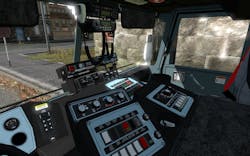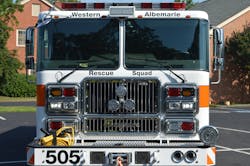Apparatus Architect: The View from the Front Seat
Fire apparatus produced during the 1950s and earlier offered open-cab designs that allowed the driver and officer a clear, unobstructed view of the streets and buildings during a response. While some departments opted for enclosed canopy-style cabs, others were reluctant to change, as the visibility offered with an open cab to them far outweighed concerns for crew comfort and protection from the elements.
Starting in the late 1960s, with diesel engines replacing gasoline power, custom cab design began to change. Apparatus cabs produced during this period were typically 76 inches wide with an individual bucket-style seat for the driver and a short bench seat for two personnel, including the officer. With no engine tunnel between the driver and officer, there was adequate room for personnel seating as well as an occasionally mounted SCBA and map book rack. The rear-facing crew seats—often referred to as jump seats or buckets—on either side of the engine enclosure had limited space but were considered acceptable as crews were outfitted with three-quarter boots, rubber coats and helmets. During the war years, many departments modified these open-cab units with makeshift plywood roofs and enclosures and, consequently, open-cab apparatus quickly fell out of favor with most departments.
While four-door cab apparatus would not be required until the early 1990s, some departments, such as those in New York City, began to specify enclosed-cab apparatus as early as 1968. In 1971, FDNY took delivery of 40 Mack CF model pumpers that came equipped with four-door cab enclosures to protect the crew. This enclosed-cab design enhanced crew safety and was modestly sized, with the exterior cab measuring 92 inches wide. The seating position for the driver provided an unobstructed view through the windshield, and due to the short bumper to front axle dimension of 72 inches.
Tight quarters
Fire departments have been operating with four-door cab apparatus ever since; however, the available space for crew seating, tools and equipment have changed dramatically since the 1970s, when NFPA standards covering apparatus design and configurations were not nearly as comprehensive as the current NFPA 1901: Standard for Automotive Fire Apparatus. Partially due to engine emission technology, radio and mapping equipment, together with EMS and other equipment mounted within the cab, the available space for crew seating is at a premium. Today, some apparatus cabs and apparatus bodies measure 100 inches in width, and yet one of the most common complaints for the driver and officer’s seat positions is inadequate room, particularly at the hip and shoulder area.
Regardless of the manufacturer and model of custom fire chassis, your department’s choice of the overall width and length of the apparatus will significantly impact the vehicle’s ability to safely maneuver within the response district. Several departments that migrated to the wider cabs to provide the maximum space for the driver and officer’s seat positions found that the wider cab changed the ability of the apparatus to operate in restricted areas.
Interiors evolve
Fire apparatus innovations have largely been driven by a combination of technology and governmental regulations. Some of us may remember signs on the rear of commercial trucks that read “Caution Air Brakes” during a time when most apparatus were equipped with hydraulic brake systems. The fire service was unfortunately unsuccessful in obtaining a waiver from the EPA diesel engine emission standards, with the result being more technology that had to be integrated into the cab and chassis components.
Over the past decade, several apparatus manufacturers have introduced cab interior designs that featured metal components finished with LINE-X or other similar non-marring surfaces for the dashboard and interior surfaces in lieu of formed plastic parts. These cab interiors were marketed as extreme duty and severe service models for use by departments with heavy run activity. Along with these enhancements, the design and layout of the dashboard and instrument panels resulted in departments enjoying flexibility in choosing where specific banks of switches would control vehicle functions, emergency and scene lighting. The end result of these cab interior options, along with the installation of radio and computer equipment, has created instances where some of these components are mounted on top of the dashboard area.
Options abound
Custom fire truck chassis continue to represent at least 50 percent of new apparatus acquired each year. The specifications for the standard custom pumper are over 100 pages long, with half of these representing details on the chassis and cab components. Much of the verbiage covering the dashboard and instrument panel are specific to each manufacturer and model of cab configuration.
Chassis that have multiplex electrical systems generally have fewer manual switches, as various vehicle functions can be controlled using touch screens with different pages designated to indicate specific operations. Hardwired electrical systems use rocker switches set up in banks that can be utilized to control chassis components as well as emergency, scene and running lighting. While many of these functional controls can be chosen by the department, care should be exercised to arrange the various switches in a logical fashion, based upon frequency of use and ease of access from the driver’s position.
The commercial truck market has placed great emphasis on interior cab design to enhance the safety and ease of operation for the driver. The Class 7 and 8 truck market represents a much larger number of vehicles produced annually when compared to the fire apparatus acquired. Owner/operators and fleet managers provide valuable feedback to the commercial chassis manufacturers on vehicle performance and design.
The conventional engine-forward commercial chassis offers superior visibility through the windshield due to the design of the dashboard instrumentation, sloped hood and door window location. In this area, the heavy truck industry is far ahead of the custom fire chassis market with respect to the driver’s comfort, seat position and safety enhancements.
Departments that are in the process of acquiring a new custom chassis apparatus should take the following steps when it comes to areas that enhance the operational capabilities of the vehicle:
· Review existing apparatus for location and placement of master switch, ignition and functional controls, including radios, mobile data terminal (MDT), map books and other engine tunnel-mounted equipment.
· Evaluate prior to contract the line of sight through the windshield from the driver’s seat position for the various models of cabs under consideration.
· Validate the mounting location for all fire department-supplied equipment inside of the cab, after determining the frequency and use for this equipment.
The arrangement of the front dashboard across the full width of the cab may impede the vision of the driver on the right side of the vehicle. Consideration should be given to using a down-view mirror mounted at the right corner of the cab to enable the driver to easily spot this portion of the apparatus, especially when operating in tight areas.
In sum
When developing specifications for new apparatus there are many areas to consider regarding safety, operational needs, maintenance and past experience. The driver and officer’s seating arrangements should be of primary importance to ensure that both personnel have a clear view from their positions.


